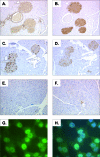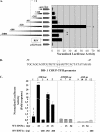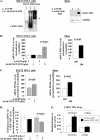The MODY1 gene for hepatocyte nuclear factor 4alpha and a feedback loop control COUP-TFII expression in pancreatic beta cells
- PMID: 18474611
- PMCID: PMC2447131
- DOI: 10.1128/MCB.01191-07
The MODY1 gene for hepatocyte nuclear factor 4alpha and a feedback loop control COUP-TFII expression in pancreatic beta cells
Abstract
Pancreatic islet beta cell differentiation and function are dependent upon a group of transcription factors that maintain the expression of key genes and suppress others. Knockout mice with the heterozygous deletion of the gene for chicken ovalbumin upstream promoter-transcription factor II (COUP-TFII) or the complete disruption of the gene for hepatocyte nuclear factor 4alpha (HNF4alpha) in pancreatic beta cells have similar insulin secretion defects, leading us to hypothesize that there is transcriptional cross talk between these two nuclear receptors. Here, we demonstrate specific HNF4alpha activation of a reporter plasmid containing the COUP-TFII gene promoter region in transfected pancreatic beta cells. The stable association of the endogenous HNF4alpha with a region of the COUP-TFII gene promoter that contains a direct repeat 1 (DR-1) binding site was revealed by chromatin immunoprecipitation. Mutation experiments showed that this DR-1 site is essential for HNF4alpha transactivation of COUP-TFII. The dominant negative suppression of HNF4alpha function decreased endogenous COUP-TFII expression, and the specific inactivation of COUP-TFII by small interfering RNA caused HNF4alpha mRNA levels in 832/13 INS-1 cells to decrease. This positive regulation of HNF4alpha by COUP-TFII was confirmed by the adenovirus-mediated overexpression of human COUP-TFII (hCOUP-TFII), which increased HNF4alpha mRNA levels in 832/13 INS-1 cells and in mouse pancreatic islets. Finally, hCOUP-TFII overexpression showed that there is direct COUP-TFII autorepression, as COUP-TFII occupies the proximal DR-1 binding site of its own gene in vivo. Therefore, COUP-TFII may contribute to the control of insulin secretion through the complex HNF4alpha/maturity-onset diabetes of the young 1 (MODY1) transcription factor network operating in beta cells.
Figures







References
-
- Bardoux, P., P. Zhang, D. Flamez, A. Perilhou, T. Lavin, J. Tanti, K. Hellemans, E. Gomas, C. Godard, F. Andreelli, M. Buccheri, A. Kahn, Y. Le Marchand-Brustel, R. Burcelin, F. Schuit, and M. Vasseur-Cognet. 2005. Essential role of chicken ovalbumin upstream promoter-transcription factor II in insulin secretion and insulin sensitivity revealed by conditional gene knockout. Diabetes 541357-1363. - PubMed
-
- Briancon, N., A. Bailly, F. Clotman, P. Jacquemin, F. P. Lemaigre, and M. C. Weiss. 2004. Expression of the alpha7 isoform of hepatocyte nuclear factor (HNF) 4 is activated by HNF6/OC-2 and HNF1 and repressed by HNF4alpha1 in the liver. J. Biol. Chem. 27933398-33408. - PubMed
-
- Cooney, A., S. Tsai, B. O'Malley, and M. Tsai. 1992. Chicken ovalbumin upstream promoter transcription factor (COUP-TF) dimers bind to different GGTCA response elements, allowing COUP-TF to repress hormonal induction of the vitamin D3, thyroid hormone, and retinoic acid receptors. Mol. Cell. Biol. 124153-4163. - PMC - PubMed
-
- Gourdon, L., D. Lou, M. Raymondjean, M. Vasseur-Cognet, and A. Kahn. 1999. Negative cyclic AMP response elements in the promoter of the L-type pyruvate kinase gene. FEBS Lett. 4599-14. - PubMed
Publication types
MeSH terms
Substances
LinkOut - more resources
Full Text Sources
Molecular Biology Databases
